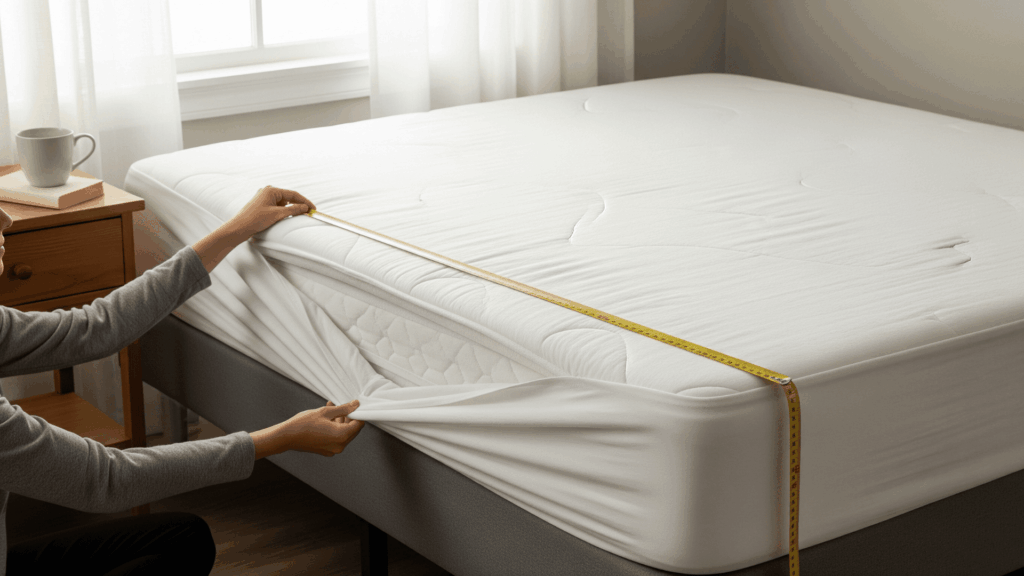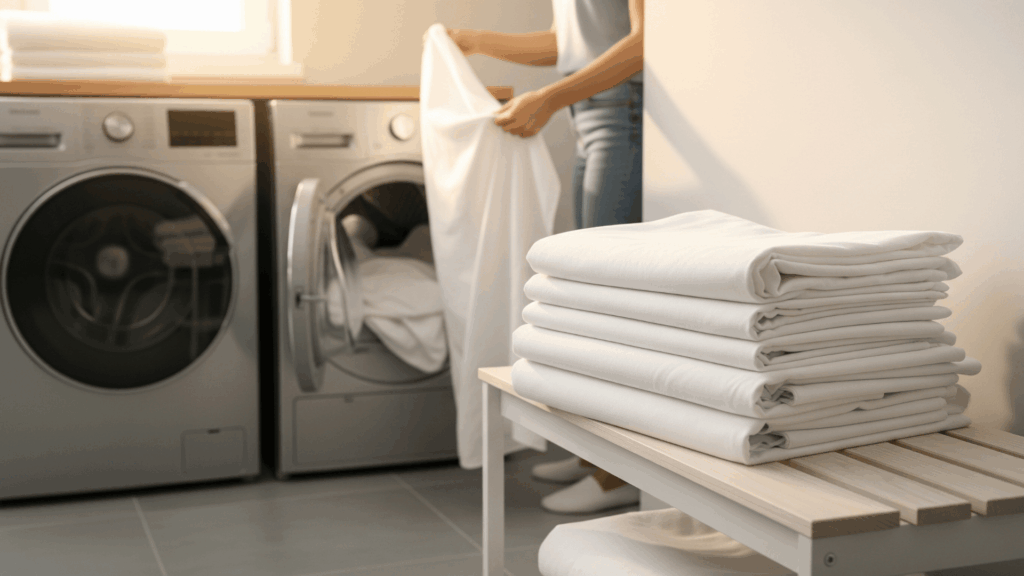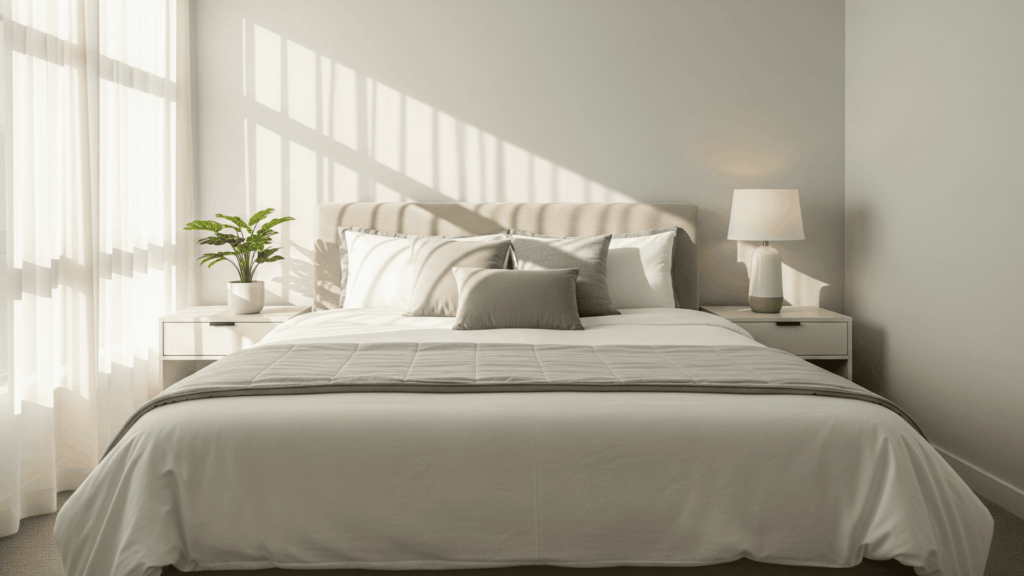Have you ever bought a gorgeous sheet set only to realize it doesn’t fit your mattress properly? I’ve been there, and trust me, it’s frustrating.
That’s why understanding sheet sizes in inches is so essential. It removes the guesswork from shopping and ensures a snug, cozy fit every time.
In this blog, I’ll break down bed sheet sizes for every mattress type and explain how queen sheet dimensions compare to others. You’ll also find easy-to-read charts and helpful tips to guide your decision.
If you sleep on a twin, full, queen, or king bed, this guide will make everything simpler. From fitted and flat sheets to pocket depths, I’ll help you figure out what matters.
Let’s get into these sizes and make your bed the most comfortable place in your home.
Understanding Bed Sheet Sizes: Why Inches Matter
When buying new bedding, terms like twin, full, queen, and king are everywhere. But the real key to a perfect fit lies in knowing bed sheet sizes in inches.
These measurements help you avoid sheets that are too tight or too loose. For example, a standard queen mattress is 60 x 80 inches, but fitted sheets also need to accommodate the mattress depth.
Always check three essential dimensions: width, length, and pocket depth. This trio ensures the sheet fits snugly, even if your mattress includes a topper or pillow top.
Standard names can vary by brand, but inches provide universal clarity.
Inches also matter when shopping online, where visual size differences are hard to spot. By sticking to inch-based dimensions, you can confidently choose sheets that truly fit your bed, no surprises or returns required.
Standard Bed Sheet Sizes in Inches

Choosing the right sheet starts with knowing the exact size of your mattress. Below is a clear, easy-to-use chart that lists standard bed sheet sizes in inches, covering flat sheets, fitted sheets, and mattress dimensions for every common bed type. Use this guide before you shop.
| BED SIZE | FLAT SHEET (W X L) | FITTED SHEET (W X L X D) | MATTRESS (W X L) |
|---|---|---|---|
| Twin | 66″ x 96″ | 39″ x 75″ x 14″ | 39″ x 75″ |
| Twin XL | 66″ x 102″ | 39″ x 80″ x 14″ | 39″ x 80″ |
| Full | 81″ x 96″ | 54″ x 75″ x 14″ | 54″ x 75″ |
| Queen | 90″ x 102″ | 60″ x 80″ x 14″ | 60″ x 80″ |
| King | 108″ x 102″ | 76″ x 80″ x 14″ | 76″ x 80″ |
| Cal King | 108″ x 102″ | 72″ x 84″ x 14″ | 72″ x 84″ |
Queen Sheet Dimensions: What You Need to Know
When selecting queen sheet dimensions, it’s important to remember that not all queen beds are created equal.
A standard queen mattress measures 60 inches wide and 80 inches long, so your fitted sheet should match these exact measurements.
However, the depth of your mattress matters just as much. If you have a thick or pillow-top mattress, look for deep-pocket fitted sheets that can fit depths of 16 to 18 inches.
Flat sheets for queen beds are typically larger to allow for easy tucking, usually around 90 x 102 inches. These provide a comfortable overhang and keep the sheet in place.
Be cautious with sheets labeled “luxury fit” or “oversized,” as they may not suit standard mattresses and can cause bunching. Always measure your mattress in inches before purchasing to ensure the best fit.
Fitted vs. Flat Sheets: Know the Difference in Sizes
Understanding the difference between fitted and flat sheets can save you from sizing issues. Each type has a specific role and unique size requirements.
| FEATURE | FITTED SHEET | FLAT SHEET |
|---|---|---|
| Purpose | Covers and grips the mattress tightly | Lies over the sleeper and the mattress |
| Sizing Needs | Exact match to mattress (W x L x Depth) | Larger than a mattress for tucking |
| Example (Queen) | 60″ x 80″ x 14″ | 90″ x 102″ |
| Depth Factor | Important to match pocket depth | Depth is not a factor |
| Fit Style | Elastic corners to stay in place | Loose and tucked under the mattress edges |
Key Considerations for Choosing the Right Bed Sheet Size

Choosing the right bed sheet goes beyond just knowing the bed size. You need to think about how you sleep, the structure of your mattress, and how you like your bedding to feel. These key tips will help you find the ideal fit and comfort.
- Measure Your Mattress Properly: Use a tape measure to get the exact width, length, and depth of your mattress. Even a memory foam topper or padded cover can change the sheet size you need, especially when choosing fitted sheets.
- Know the Sheet’s Purpose: Fitted sheets are designed to hug the mattress tightly, ideal for restless sleepers. Flat sheets add a smooth top layer and are great for those who like the tucked-in look and added warmth.
- Check for Pocket Depths: Modern mattresses are often taller than older ones. If yours is over 12 inches thick, look for deep-pocket sheets that fit 14, 16, or even 18 inches without slipping off the corners.
- Don’t Rely on Labels Alone: Not all “queen” or “king” sheets are made the same across brands. The safest option is to always check the exact measurements in inches listed on the packaging or product page.
- Match Sheet Type to Comfort Needs: For a tucked-in, crisp bed feel, oversized flat sheets are perfect. If you want a sheet that stays in place all night, opt for a fitted sheet with strong elastic and the proper pocket depth.
Bed Sheet Sizes for Specialty Mattresses
Specialty mattresses such as those in RVs, adjustable bases, or hospital beds often come in unique sizes that differ from standard twin, full, or queen beds.
| Tip | Details |
|---|---|
| Check the Manufacturer’s Guide | Find exact dimensions on the mattress tag or the brand’s website. |
| Avoid Standard Sizes | Specialty mattresses vary in width, length, and depth. |
| Use Elastic-Corner Sheets | These fit better on adjustable or irregular mattresses. |
| Measure Carefully | Even a 1-inch difference can lead to a poor fit. |
| Record Exact Measurements | Helps you buy the right sheets and avoid costly returns. |
Tips to Maintain the Perfect Sheet Fit Over Time

Keep your sheets fitting well and feeling comfy with a little care. The right habits can help them stay snug, stretchy, and in good shape for years. A few easy tips to make them last longer are:
- Wash in Cold Water: Always use cold water when washing sheets, especially if they’re made of cotton or bamboo. Hot water can lead to shrinkage, distorting the original size. Cold cycles preserve the fibers and help maintain accurate dimensions.
- Dry on Low Heat: Avoid using high heat when drying your sheets. Intense heat can weaken elastic edges and reduce overall stretch. Choose low tumble settings or air dry to keep the shape intact.
- Rotate Sheet Sets: Don’t use the same sheet set every week. Rotating between multiple sets reduces constant wear and tear. This practice keeps elastic tension strong and ensures all sets last longer.
- Fold and Store Properly: Neatly folding and storing your sheets avoids unnecessary stretching or warping. Keep them in a cool, dry place to prevent fabric breakdown. Well-kept sheets fit better when reused.
- Avoid Overloading the Washer: Stuffing too many items into the washer causes friction and strain on fabric. Wash sheets in moderate loads for thorough cleaning and to maintain their original fit. This helps the elastic stay strong.
Conclusion
I hope this guide made sheet sizes in inches easier to understand and helped you feel more confident about buying the right fit.
From tackling queen sheet dimensions to distinguishing between fitted and flat sheets, every detail plays a part in getting that perfect snug fit.
I’ve learned from experience that measuring in inches removes all the guesswork and saves you from returns and frustration.
If you’re upgrading your bed or helping someone else find the correct set, knowledge truly makes the process smoother.
If this blog cleared up your confusion or taught you something new, share it with your friends, family, or anyone tired of struggling with ill-fitting sheets. A perfectly made bed could be just one helpful link away.

